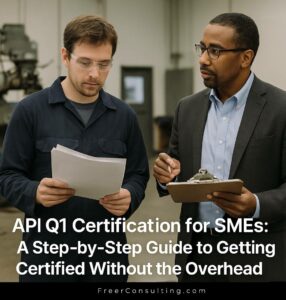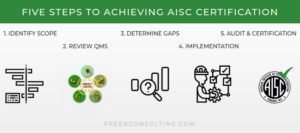Are you looking to get AISC certified but you do not know where to begin? Obtaining your AISC 207-20 certification can be broken down into five steps: identify applicable sections from the standard, review existing documents and records, determine the gaps, implement the revised quality management system, and conduct an internal audit.
1: Identify your scope
Figuring out your scope of work is the initial step for certification since your scope determines which requirements in AISC 207-20 apply to your line of work. It will be a combination of the Chapter 1 General Requirements and the supplemental Chapters 2 through 6 depending on if you are building fabricators, component manufacturers, bridge fabricators, erectors, or hydraulic metal structure fabricators.
Another thing to keep in mind is your timeline for certification. Do you need to be certified within 6 months to accept a bid for an upcoming project? Do you want to be certified within a year to start looking for AISC projects to bid on? Whatever the case, it will be essential to prepare a schedule to track your certification progress.
2: Review your current QMS
While reviewing your existing quality management system, keep in mind these questions:
For your quality manual, is there a quality policy and quality objectives stated? Are documented procedures referenced in the quality manual? Are key job functions outlined with responsibilities, authority, required qualifications, and activities? The quality manual is one of the first documents an auditor reviews and should clearly map out your quality management system.
For documented procedures, what types of procedures should be documented? Any activity or process that must be performed consistently and that must meet AISC standard should be documented such as:
• reviewing contract and project specification;
• controlling documents and maintaining records;
• detailing and checking fabrication and erection documents;
• fabrication, manufacturing, and erection processes such as welding, bolting, and coating;
• inspection and testing;
• calibrating and maintaining equipment;
• evaluating subcontractors and suppliers;
• purchasing;
• controlling nonconformances;
• performing corrective actions;
• and conducting internal audits.
What should these documents look like? Are they sectioned out and bulleted? Are they flowcharts with detailed steps? Whatever you choose, ensure that the procedures are easy to follow, that training on these procedures is effective, and that auditors can easily review them.
For quality records, how are the records stored in the QMS? A simple folder structure by process will help keep things organized and allow easy access to documents when you need it most, especially during an audit or inspection. Is there existing software in place that records are uploaded to? For example, a project management software can keep purchase orders, MTRs, customer provided documentation, work orders, and inspections and tests all in one project. Getting your records organized is crucial in showing auditors as well as yourself that you are in control of your QMS.
3: Determine the gaps in QMS
Once you have reviewed your current QMS with the AISC 207-20 requirements, determine what is missing or needs improvement to bring your QMS up to conformity. Are there missing certifications for welders? Do all applicable materials have MTRs? Are there MSDS sheets for painting/coating material? Developing a checklist and schedule will help you determine what needs to be completed and how much you need to fast-track the remaining work to bring your QMS up to compliance. Create and/or update required documentation and obtain missing records.
4: Implement the new QMS
Provide training on the new QMS and evaluate the effectiveness of the new system. Are there still gaps that need to be addressed? Are there certain processes that can be improved? Does the QMS need to be re-organized to be easier to navigate? Address any issue or concerns to bring the QMS to conformance and to find an organization system that works for you. Do your due diligence to maintain your QMS and stay on top of organizing your documents. You want to avoid being unprepared for an audit or inspection and having to spend extra time scrambling to get your ducks in a row.
5: Conduct an internal audit
Review the new QMS with an internal audit. Does the QMS meet the requirements of AISC 207-20 and its referenced standards? Is the new system ready to be audited by AISC? If not, identify the areas that need to be improved, update the QMS, and provide any necessary training. Once you are confident with your QMS, schedule for certification and prepare the necessary documents for the big audit.
Is your company seeking to become certified in https://www.freerconsulting.com/industrial-standards-certifications-consulting Do you need to update your current management system to comply with the new standard? Freer Consulting can help.







